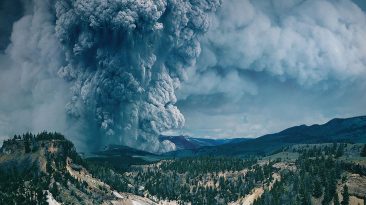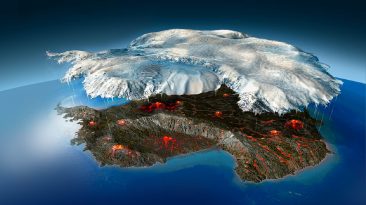Ahh, spring has sprung. Robins are chirping. Flowers are blooming. Yikes, it’s getting a little windy out. Wait a minute. Do you hear that? Is it just me or does it look like the lake is moving? Oh no, this is bad. Really bad. Time to go. Kids, pack your things. It’s a freaking ice tsunami. How do ice tsunamis form? How tall can they get? Could New York be in danger?
When you hear the term ice tsunami, you might think of the giant waves caused by a glacier collapsing. Well, allow me to break the ice. What we’re referring to is more commonly known as an “ice shove.” Ice shoves, or ice tsunamis, are rare events. High winds push melting ice toward a gently sloping shoreline. Generally, you need a wind speed of about 119 km/h (74 mph) to trigger one.
Once the ice starts flowing, it can surge on to land with unstoppable momentum, forming walls as high as 9 to12 m (30 to 40 ft). These ice walls are known as ice-push ramparts. They can be forceful enough to move giant boulders of ice, ranging from 0.9m (3 ft) to 1.5m (5 ft) wide. Ice shoves have enough weight and power to break steel-reinforced concrete walls. So, your best bet is to move far away from them. But could an ice tsunami engulf all of the United States?
The likelihood of an ice tsunami reaching the mainland of the U.S. is pretty slim. But if you happen to live in East Hampton, Montauk, or Long Beach, there is a higher chance of coastal flooding and ice shoves. New York has 431,000 people at risk of coastal flooding, and most of these people live on Long Island. But unfortunately, this number is set to increase to 659,000 people by the year 2050 due to climate change.
Manhattan would escape this icy wrath simply because it’s on a relatively small bay. The winds probably wouldn’t reach the same speeds as more exposed coastal areas. While ice tsunamis can move several hundred meters over land, Long Island alone is about 30 km (18 mi) wide. So unless you live by the shore, you’d likely be untouched. So sit back, relax, and enjoy that giant iced-tea.
In February of 2019, residents along the shorelines of Lake Erie weren’t so lucky. A giant ice tsunami wreaked havoc on people’s homes and formed massive walls of ice boulders. Mark Robinson, a local meteorologist with The Weather Network, remarked, “I’ve never seen ice moving that fast. It was crazy fast.”
With winds reaching 113 km/h (70 mph), walls of ice bulldozed trees, street lamps, and houses. Meteorologists estimate that there could have been as much as 13.5 billion tons of ice covering the 362 km (224 mi) long lake. There was also an ice surge at Lake Mille Lacs in Onamia, Minnesota, in 2014.
It was powerful enough to wipeout two-dozen, two-story buildings. Luckily, no one was hurt by this fluke of nature. But I’m pretty sure their insurance bills took quite a hit. While there was a lot of property damage, it did make for some pretty fun slides. With more earthquakes and hurricanes reported each year, we may have bigger problems on our hands than an ice tsunami. Could a mega-tsunami engulf the United States in our lifetime?
Sources
- “Furious Winds Lead To ‘Ice Tsunamis’ Along Lake Erie”. Brigit Katz. 2019. smithsonianmag.com.
- “Ice Shoves: The Force Of Nature In Slow Motion”. Tom Niziol. 2020. wunderground.com.
- “How Is A Tsunami Created?”. John London. 2017. sciencing.com.
- “‘Ice Tsunami’ Tears Through House Like It’s Made Of Matchwood”. Rob Waugh. 2014. metro.co.uk.
- “Ice Motion And Driving Forces During A Spring Ice Shove On The Alaskan Chukchi Coast”. Mahoney, Andrew, Hajo Eicken, Lewis Shapiro, and Tom C. Grenfell. 2004. Journal Of Glaciology 50 (169): 195-207. doi:10.3189/172756504781830141. cambridge.org.


















